Probably the most popular left-handed guitar player of all time is Paul McCartney. He mostly uses left-handed guitars, but he can also use right-handed guitars playing them in a left-handed way. If you’re left-handed and you want to learn the guitar, then you have two options.
You can use a left-handed guitar, which is uncommon and more expensive than a regular guitar, or you can use a regular guitar and play it left-handed. But whatever you choose, you must learn how to play left-handed guitar chords.
Why Would You Want to Learn to Play the Left-Handed Guitar Anyway?

You might have taken an interest in playing the guitar as inspired by popular left-handed players like Paul McCartney, Tony Iommi, and Jonathan Butler. You may have given up on trying to learn how to play right-handed chords, or you want to polish your left-handed guitar playing. To get you started with learning left-handed guitar, remember the following important techniques.
Getting in the Right Mindset

Nothing is easy when it comes to playing the guitar; this is why you must keep a level head and be patient. If you play regular guitar before, then you know how hard it is to learn different chords and to perfect each one. So with left-handed chords, you’ll be doing these all over again.
You need to be patient and spend enough time to learn new chords. Schedule at least an hour a day of learning the basics so you’ll be able to play like its second nature to you. Also, you must stay positive. As we have said many times, playing a left-handed guitar is not an easy task, but it can be learned. With positive thinking, you’ll have the proper mindset to learn anything, even something as complicated as left-handed guitar chords.
Getting the Right Tools for the Job

You have the option to use a left-handed guitar or use a regular one and just flip it over if you want to learn basic guitar chords. If you wish to use option A, then consider then you need to purchase a guitar designed for left-handed people.
Take note that the overall style and appearance of left-handed guitars are the same as regular guitars, but there are several adjustments. These were considered so people can play more comfortably.
The neck of a left-handed guitar is on the left of the player, while the neck of right-handed guitars is on the right side of the player.
The strings are different too. Left-handed guitars have strings that are positioned upside down. This is so to help players play easily and without any hand, arm, or wrist discomfort.
The body of a left-handed guitar is found on the opposite side of the instrument. This is the opposite of the body location of a right-handed guitar. The cutaway of a left-handed guitar is beneath the high E string.
Meanwhile, the tuners of a left-handed guitar are opposite the headstock. At this position, the player can access it whenever he needs to tune his guitar even while in play.
Choosing between a left and a right-handed guitar may be confusing because most guitar players don’t even know the difference between the two. And aside from considering whether to take a left-handed guitar or just settle with a regular guitar, you must choose according to which instrument is more comfortable for you to play.
Aside from having the right guitar to use as you learn how to play left-handed chords, you must also consider some important things. A music stand would be great, so you can have a secure and efficient place to keep your chord sheet or music sheet as you play. The best music stand should be height adjustable so you can play while standing up or sitting down. The desk or tray (the place where you place your music sheets) must be strong enough to hold a music book or a tablet or your mobile phone. Most music players use tablets to play chords directly found online or chords stored from their hard drive or cloud. And finally, consider a music stand made from strong material so it can last for a long time.
Choose quality guitar accessories like guitar straps, picks, and amps if you want to improve your music playing. You may already have these accessories if you play right-handed guitars before, so there’s no need to buy new ones. These will do well with a left-handed guitar as well.
You also need a guitar chord guide book for left-handed players. We have you covered with five of the top guitar guide books, which we will feature later in our guide.
Proper Finger Placement

To properly play a left-handed guitar and left-handed chords, you must learn proper finger placement. The best finger placement is at the back of the fret. If while playing a note and you see that your finger is positioned in the middle or at the back of the fret, move this up till you are very near the fret. This position will help you make clean and clear notes.
Listen to the notes that you’re making; this will help determine if your fingers are at the correct positions. If you notice some buzzing when you strike a note, check your fingers. Usually, you only need to make minor adjustments so you can remove some of the buzzing. Make sure to keep your thumb in the middle of the neck. By placing the thumb in this position, you can remove most of the problems like the tension that bad techniques usually create.
Here is a simple technique to help you focus on relaxing your fingers and on promoting better finger placement.
- Place the first finger on the third fret of the sixth string.
- Remain on the low E and play the fourth fret using your second finger.
- Complete the low E by playing the fifth fret using your third finger. Consider this as a pattern for all the six strings.
- Move the A string and play the third, fourth, and fifth frets using the first, second, and third fingers. Do the same with the D, G, B and the E strings.
This is a simple exercise, and you don’t need to remember a chord or scale. With this exercise, you can focus on your techniques for your left hand. Take your time and start slowly. Take time to keep everything clean, and only when you have mastered these will you be able to pick up some speed. Perform these finger placement techniques at least ten minutes a day. Do these slowly so your hands, wrist, and fingers will take time to adjust. If you overdo it, you can end up hurting your hands in the process.
Finally, learn everything by heart. Take note of the numbers that your fingers represent the guitar string notes and the basic guitar parts. If you still have questions about these, backtrack your lessons and start over.
Guitar Chord Basics

Presuming you have a good left-handed guitar handy and you know by heart the proper finger placement basics, now we proceed with learning about guitar chords for left-handers.
Major guitar chords for left-handed players
C Major

In a C Major chord, you’ll be using fingers 1, 2, and 3 and will be positioned this way:
- Put the first finger on the fifth string of the first fret.
- Put the second finger on the third string of the second fret.
- Put the third finger on the second string of the third fret.
- Strum string 5 but open string 6 and mute string one.
Begin with positioning your fingers the proper way, not strumming first; just get the feel of stretching your fingers across the board. Remove your fingers and place them back again and when you have the hang of the new position, strum the strings. Correct the placement of each finger if you hear some buzzing sounds.
D Major
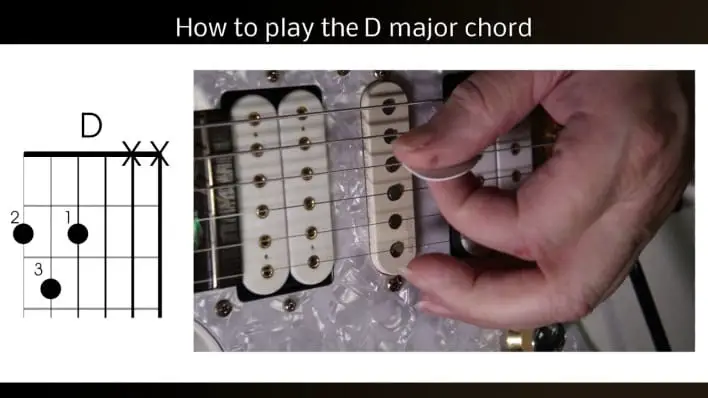
With the D Major chord, you will be using fingers 1, 2, and 3, and these will be positioned this way:
- Put the first finger on the fourth string of the second fret.
- Put the second finger on the sixth string of the second fret.
- Put the third finger on the fifth string of the third fret.
- Play the third string open and mute the first and second strings.
Playing the D Major chord requires you to stretch your hand and reach for the higher strings, and thus, you must take time to get used to this awkward position. Practice finger placement first, take your fingers away and back again on the board. Only when you can quickly work in this position will you be able to practice strumming. Strum fully and notice buzzing common in first-time players. Correct finger positions and repeat strumming until you achieve a clean and clear D Major chord.
E Major

Now the E Major chord uses fingers 1, 2, and 3 and these will be positioned this way:
- Put the first finger on the fourth string of the first fret.
- Put the second finger on the third string of the second fret.
- Put the third finger on the second string of the second fret.
- Play the first, fifth, and sixth strings open.
The E Major chord is very easy because your fingers will be placed in the middle of the board. There’s no need to stretch to reach a higher string and to crunch your fingers down to reach the lower strings. But as always, practice placing and removing your fingers quickly but properly. Play the note after you’re sure your fingers are correctly positioned. Some buzzing may be heard despite being an easy chord, but you can quickly correct this, so you’re up for a clean and clear note.
F Major

F Major is played by the first, second, and third fingers, and these are placed this way:
- Put the first finger on the fifth string of the first fret.
- Put the second finger on the fourth string of the second fret.
- Put the third finger on the third string of the third fret.
- Play string 6 at open and mute first and second string.
Playing the F Major chord is moderately hard and easy. You’ll be stretching your first finger to reach the 5th string and making sure the second and third are carefully placed on top of the strings in the middle of the 2nd and 3rd fret. It can take time to get used to, but no doubt it’s bearable. Don’t forget to practice placing and removing your fingers until it’s easy to do so. Strum a clean and clear note by removing buzzing produced by improperly placed fingers.
G Major

The G Major chord makes use of the first, second, and third fingers and these are positioned this way:
- Put the first finger on the second string of the second fret.
- Put the second finger on the first string of the third fret.
- Put the third finger on the sixth string of the third fret.
- Play the third, fourth, and fifth strings open.
Your third finger will be stretching far to the sixth string this time, and this is stretching too much. Also, take note that your first and second fingers remain on the bottom two strings as the third is stretched; this is not a comfortable position at all. Practice finger placement for G Major well, but don’t overdo it. Nothing is worse than tired and achy fingers, which will mostly result in more buzzing and totally unpleasant noise.
A Major
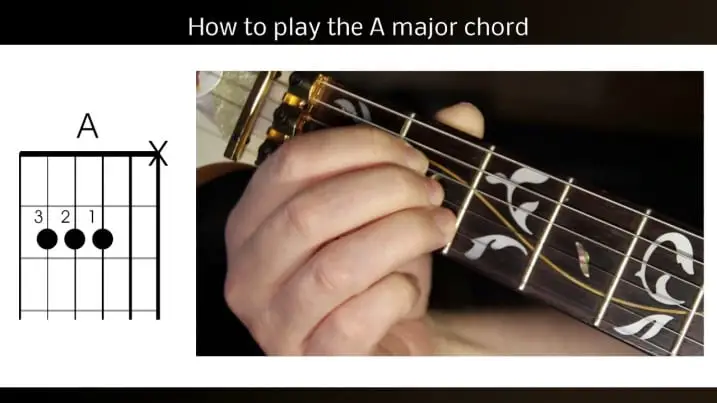
The A Major chord is played by the first, second, and third fingers and these are positioned this way:
- Put the first finger on the fifth string of the second fret.
- Put the second finger on the fourth string of the second fret.
- Put the third finger on the third string of the second fret.
- Play the second and sixth strings open and mute first string.
The A Major chord is a simple chord that collects the three fingers on the second fret. It is easy to produce and is easy to master too. You won’t have to worry about buzzing because each finger supports each other as this note is played.
B Major
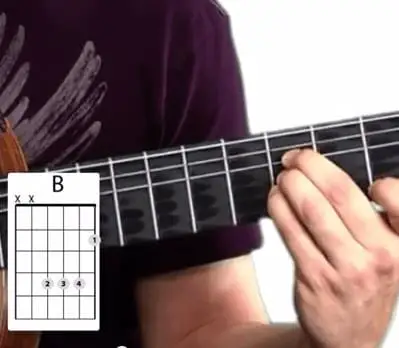
The B Major chord uses the first; second, third, and fourth fingers, and these are positioned this way:
- Put the first finger on the sixth string of the second fret.
- Put the second finger on the fifth string of the fourth fret.
- Put the third finger on the fourth string of the fourth fret.
- Put the fourth finger on the third string of the fourth fret.
- Mute the first and second strings.
B Major is yet another difficult chord to play whether you’re using the right hand or left hand. This is because the first finger has to reach the sixth string while the remaining fingers need to stay in line on the fourth fret. Perform some light finger exercises before you proceed with learning tough guitar chord positions like this one. Also, don’t forget to place your fingers on and off the board until you feel it’s easy to position the B Major. Strum with gusto and listen for any buzzing. This is mostly due to an improperly placed first finger on the sixth string.
Minor guitar chords for left-handed players
A Minor

The A Minor chord is played with the first, second, and third fingers and these are positioned this way:
- Put the first finger on the fifth string of the first fret.
- Put the second finger on the fourth string of the second fret.
- Put the third finger on the third string of the second fret.
- Play the second and sixth strings open and mute the first string.
A Minor is one of the easiest minor chords to play because all the fingers involved are placed in the middle strings and in the first and second frets. There’s no need to stretch. Just practice proper placement, and you’ll be strumming clean and clear notes in no time.
B Minor

The B Minor chord is played by the first, second, third, and fourth fingers, and these are positioned this way.
- Put the first finger on the sixth string of the second fret.
- Put the second finger on the fifth string of the third fret.
- Put the third finger on the fourth string of the fourth fret.
- Put the fourth finger on the third string of the fourth fret.
- Mute the first and second strings.
Playing the B Minor is quite difficult, especially for first time left-handed players. Just like the B Major chord, the first finger stretches high to the sixth string to reach it, but the remaining fingers are positioned in the middle strings. It is easy to tweak this by using some easy finger tricks, especially if you find this a bit challenging to do. And as always, correct positioning reduces buzzing and other unnecessary noises.
D Minor
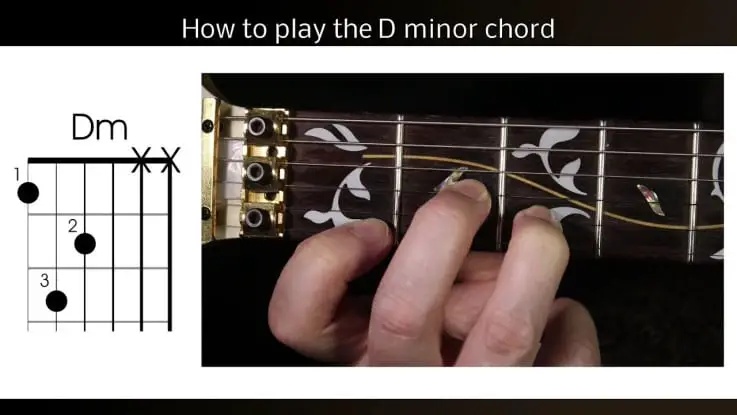
The D Minor chord uses fingers one, two, and three, and these are positioned this way.
- Put the first finger on the sixth string of the first fret.
- Put the second finger on the fourth string of the second fret.
- Put the third finger on the fifth string of the third fret.
- Play the third string open and mute the first and second strings.
Another easy left-handed chord is D Minor, and this is because all the fingers are positioned close together. You may need to reach higher on the fourth, fifth, and sixth strings, but at least all the fingers are close together, no stretching whatsoever. As always, correct positioning is the key to reduce buzzing and other noises.
E Minor

The E Minor chord is played with the first and second fingers, and these are positioned this way:
- Put the first finger on the third string of the second fret.
- Put the second finger on the second string of the second fret.
- Play the first, fourth, fifth, and sixth strings open.
The E Minor chord is possibly the easiest chord, whether you’re playing a right-handed or left. You will only use two fingers, and these are positioned conveniently on the second fret and the first and second string. It’s unlikely you’ll experience any buzzing or poorly fingered notes, but like all chords, you must practice well and aim for clean and clear notes always.
Top 5 Products
To help you find a good guitar guide book for left-handed beginner players, here are some of the best to check out.
1) The Left-Handed Guitar Chord Book
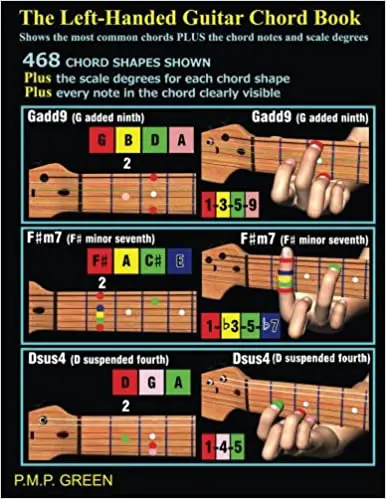
Author: Mr. P.M.P. Green
Best Guitar Chord Book for Beginner Players
Editor’s Rating: 4.3 out of 5
The Left-Handed Guitar Chord Book is a different chord reference book. It comes with 468 chords to help left-handed players. It shows not just the pattern or finger placements because it also shows the shape and the scale degrees of every chord.
First-time players will learn the shapes and understand the “RED indicators” of the chord box. The author recommends that learning this way will help students become more efficient and more proficient.
Meanwhile, advanced and intermediate players will find this guide of great help because of the unique color caps, strings, and rings in the chord box diagrams in this book. And if you’re right-handed, you can get a right-handed version of this book.
2) Left-Handed Guitar Chords Made Easy, Level 1

Author: Christian J. Triola
Best Basic Guitar Chord Book for Left-Handed Players
Editor’s Rating: 4.8 out of 5
The Left-Handed Guitar Chords Made Easy is a guide book that will help improve your skills and talents to turn you from a beginner to an average or even an expert in no time. The author claims that even if you have not played the guitar before, you can quickly learn how to do so with this book.
Every lesson will give you mastery of different lessons. It will help you move from one chord to another in the easiest way. You will also learn common strumming techniques that are used by the pros. You’ll get clear explanations and diagrams, practice exercises, strumming patterns, chord theories, barre chords, suspended chords, audio files, and many more. This book is for new and for average players.
3) The Left-Handed Guitar Chord Bible: Standard Tuning 3,024 Chords

Author: Tobe A. Richards
Best Standard Left-Handed Guitar Chord Bible
Editor’s Rating: 5 out of 5
Left-Handed Guitar Chord Bible will teach players more than 3000 chords. It is very easy to use and has a set musical progression lesson that will help you learn standard major and minor chords. Every chord comes with three versions with more than 500 moveable chord configurations included in this guide book.
This is a very comprehensive guide with sections to learn about tuning, alternative chords, fingering, fingerboard layouts, chord construction, slash chords, chord window blanks, harmonic intervals, and many more. With this book, you’ll be able to use any kind of songbook and get access to any advanced chords.
4) Big Left Handed Guitar Chord Book

Author: Richard Moran
Best Big Format Left-Handed Guitar Chord Book
Editor’s Rating: 4.1 out of 5
The Big Left Handed Guitar Chord Book shows the chords in a large format, so these are easier to see. These are also displayed horizontally on a grid rather than in a vertical manner, which is seen in most guitar guide books. With this guide book, you can enhance your learning, helping you understand chord patterns and ingest new knowledge in the fastest time.
Now, this is a special edition from 6 Strings for left-handed players. It has more than 500 chords in a small A5 formal paper. This is a handy guide book that you can carry inside your guitar case.
5) Left-Hand Guitar Chord Book
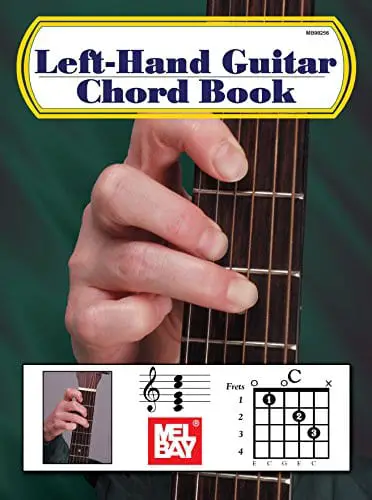
Author: William Bay
Best Kindle Edition Left-Hand Guitar Book
Editor’s Rating: 4.4 out of 5
The Left-Hand Guitar Chord Book is a chord book that comes with a guide to all the most common guitar chords. Because it’s available in Kindle form, you can learn how to read chords using your Kindle device. It comes with major chords, minor chords, altered 7ths, augmented, and diminished chords, to name a few. It has many pictures and diagrams to guide beginners, making it one of the most helpful guide books for left-handed players in the market.
How to purchase the best guitar chords guide for left-handed beginners?
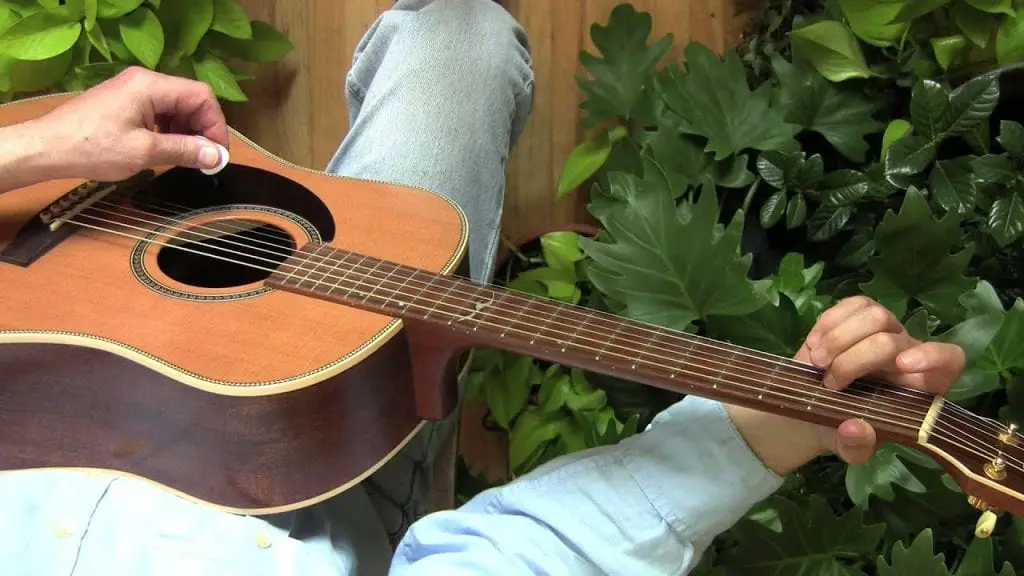
- Look for chord guides with diagrams for each chord– the diagrams must be easy to understand, with chord fingering or finger placement easy to see even at a glance.
- The more types of chords, the better – some guides come with more than 600 or 500 chords to learn. The more, the better you’ll learn how to be a better and more skilled player.
- Additional information and tips are most certainly welcome – aside from the different left-handed chords, it must-have tips, techniques, and strategies to improve your chord reading, placement, and techniques.
- The guide book must be handy, easy to take anywhere –as you want to learn chords anywhere, the guidebook must be handy and easy to carry inside your guitar bag or case or inside your bag.
- Kindle or paperback edition or downloadable edition – some people use tablets or Kindle to read guide books and other reference materials. Having a guide that’s available in this format is indeed very efficient.
FAQ
Are left-handed guitar chords different?
Left-handed guitar chords are not different from right-handed chords in such a way that these are mere upside down counterparts. Also, left-handed chords are played better on left-handed guitars.
Can you play the guitar left-handed?
Yes, a right-handed or regular guitar may be played left-handed. To play chords, place the chords upside down to get left-handed guitar chords.
How do you hold a left-handed guitar?
Left-handed guitars are played like a regular right-handed guitar; only the right-hand holds the fretboard while the left-hand strums the strings on the soundhole.
Are left-handed guitars more expensive?
Based on prices from online stores, left-handed guitars are more expensive compared to average right-handed guitars. This is because these are very uncommon musical instruments.
Can a right-handed guitar be converted to left?
Yes, a right-handed guitar may be converted to a left-handed instrument just by restringing it. However, this should be done only when you have no other choice. This is because a right-handed guitar has a nut that’s back to front; the bridge has to be adjusted before restringing and many other hardware issues.
Can a lefty play right-handed guitar?
Yes, a left-handed player may learn how to play a regular, right-handed guitar.
How do I know if a guitar is left-handed?
There are some features that are different in a left-handed guitar: the neck of a left-handed guitar is on the left, left-handed guitars have strings that are positioned upside down, and the body of a left-handed guitar is at the opposite side of the instrument. The cutaway of a left-handed guitar is under its high E string, and the tuners of a left-handed guitar are at opposite the headstock.
Conclusion
A left-handed person can learn beginner left-handed guitar easily when he has the right instrument, the proper guide book, and the correct mindset to learn. It’s a challenge to learn left-handed guitar, but it’s doable. Be sure to familiarize yourself with the different parts of a left-handed guitar, the different chords, and proper finger placement, and practice daily so you’ll become a better guitar player in no time.



